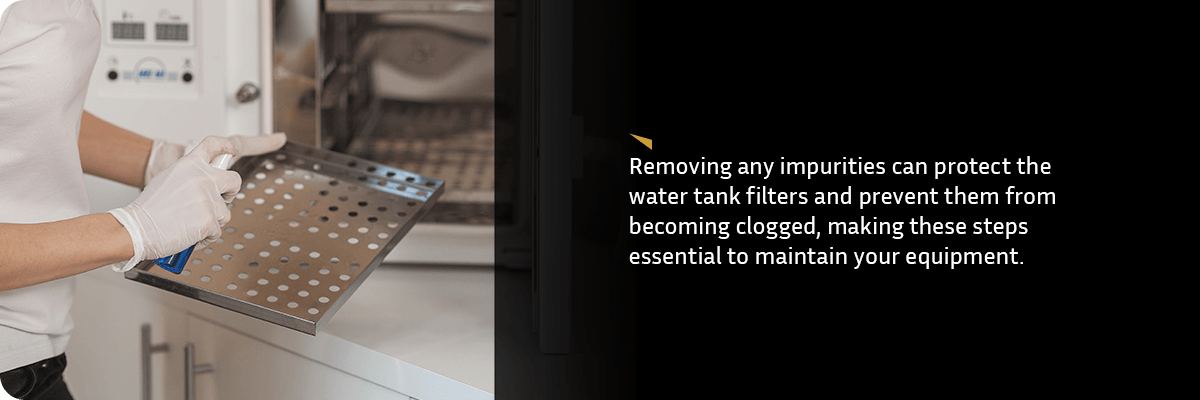Of all sterilization methods, autoclaves are the most widely used and dependable for cleaning instruments in facilities. While essential for sterilizing your medical instruments, autoclave cleaning is often overlooked. Learn how to clean an autoclave to extend your equipment’s life span and provide safe, effective and continuous operation here.
Materials You Need to Clean Your Autoclave
To clean an autoclave, you will first need some essential items:
- Specialized autoclave cleaner: A specialized cleaning solution should be used to clean and sterilize your autoclave efficiently so it is safe for use. The best cleaning solutions are designed to remove scale, rust and stains from nickel-clad or stainless steel chamber surfaces.
- Purified water: Non-chlorinated or purified water, like deionized water, can be used to clean an autoclave. This type of water has undergone a process to remove impurities, which can prevent damage to your autoclave.
- Autoclave gloves: It’s essential to wear gloves made for autoclaves before cleaning the equipment. These gloves can handle the heat and ensure your safety.
- Rag or towel: You’ll need a soft rag or towel to wipe down the autoclave’s external parts. Do not use abrasive cloths or brushes to clean the metal parts.
Autoclave Cleaning Instructions
Learning how to clean an autoclave is essential, as forgetting monthly autoclave maintenance and cleaning can lead to frequent, costly repairs and cause excessive wear to your tools. You’ll want to clean the exterior and interior parts and the water tank to ensure the equipment runs efficiently. Follow these autoclave cleaning instructions to do it correctly.
Cleaning the Autoclave’s Door and Sterilization Chamber
You should perform autoclave chamber cleaning every 25-30 cycles to remove any residue and impurities that can build up in the bottom of the chamber from regular use. Performing autoclave cleaning can remove these impurities that may cut the seal and cause the chamber to lose pressure.
Here’s how to clean these components:
- Switch the machine off and ensure it is cold before removing your baskets, trays and tray holders.
- Disassemble and remove the tray support from the chamber.
- Dampen your rag or towel with purified water or vinegar to remove any limescale.
- Use a back-and-forth scrubbing motion to clean the chamber walls, floor and ceiling.
- Clean the seal and its fold located at the mouth of the chamber, where impurities often accumulate most.
- After cleaning the chamber, spray the inside with purified water and use a towel to wipe down surfaces.
- Brush away any debris and clean the chamber drain strainer.
- Reassemble your tray support and interior parts.
Remember not to use detergent to clean out the chamber. Also, take care not to damage the probe at the bottom of the chamber.
Water Tank Cleaning
Periodically cleaning your water tanks can also help your autoclave function better and longer. Here’s how to do it:
- Empty the water tank by inserting the end of the hose connected to the bottom of the front panel into the back of an empty container.
- Do the same thing with the internal waste water tank and the transparent hose connected to the bottom of the front panel.
- After draining these tanks, remove the tubes by pressing the button on the coupling.
- Remove the cover to access the tanks.
- Using your towel, clean off impurities or deposits settled on the walls and bottom of the tank.
- Remove autoclave filters and clean with water jets.
- Re-insert the filters and refresh the tank with clean water.
- Rinse the tank and empty any water.
- Run a sterilization cycle while the chamber is empty.
Removing any impurities can protect the water tank filters and prevent them from becoming clogged, making these steps essential to maintain your equipment.

Autoclave Maintenance
Autoclaves require proper care and maintenance to keep them running efficiently. Here’s how to maintain your equipment:
Checking the Safety Valve
First, you must check the safety valve to ensure it’s functioning correctly. Follow these instructions:
- Access the safety valve located on the back of the appliance.
- Loosen the valve cap on the top by turning it counterclockwise until you reach the stroke’s end and the valve runs freely.
- Return the cap to its original position and screw it back in place.
- Repeat the above steps a few times.
- Ensure the cap is tightly closed and secure after these steps.
Maintaining the Closure System
Follow the step-by-step process of adjusting your closure system:
- For safety purposes, switch your machine off and ensure it is cold.
- Open the door and insert the adjustment lever into the slot beneath it.
- Check that the lever is engaged with the adjustment pin by observing from the door hook slot.
- Rotate the adjust pin counterclockwise and monitor the door to ensure it closes correctly.
- If the handle is too challenging to close, rotate it clockwise slightly before turning it counterclockwise.
- Conduct a test run to ensure the adjustment was effective.
Regular autoclave use can cause the equipment’s mechanical parts to settle and wear the seal. Adjusting it can ensure the pressure rises correctly and provides optimal cycle outcomes.
Common Autoclave Complications
Common autoclave complications include rust formation on surfaces or instruments caused by already rusty tools. Using disinfectants, detergents or water that contains chlorine, such as tap water, can also cause rust. Dark rings are another complication that can appear in the chamber, typically caused by residue deposits like oil or dirt from instruments.
Rust and residue build-up can prevent your autoclave from performing correctly, making instruments less sterile. To avoid build-up rust, it’s essential to clean your sterilization chamber walls and tray holders using products meant for stainless steel. Regularly following the above autoclave cleaning instructions can also prevent dark rings, as can ensuring instruments are properly cleaned and not over-lubricated before placing them in the autoclave. Knowing what you can and can’t clean in your autoclave can also help keep it functioning.
How Often Should an Autoclave Be Cleaned?
Remember to clean your autoclave daily, weekly, monthly and yearly so it functions properly:
- Daily: Perform autoclave chamber cleaning by wiping away spills after every cycle. Ensure the interior is clean and free from debris.
- Weekly: Flush the chamber with clean, purified water once a week and clean it regularly, depending on the items you sterilize. You should also drain the water from the reservoir and refill it with fresh, distilled water. A weekly spore test can also help monitor sterilization by directly killing resistant microorganisms.
- Monthly: Autoclave monthly maintenance is essential. Clean the chamber and inspect your cords and plugs for excessive wear and overheating. Replace these parts as needed to prevent a fire hazard.
- Yearly: Every year, have your autoclave inspected, cleaned, tested and calibrated. You might also have gaskets, seals and filters replaced as needed to ensure your sterilizer runs appropriately.
Following the above autoclave cleaning instructions can extend your autoclave’s life span and instruments.
Contact Jewel Precision for Autoclave Products
Autoclaves are essential in the health care industry, making it pertinent to clean and maintain them regularly. If you use autoclave sterilization methods, organize and secure your instruments with trays and cases from Jewel Precision. We provide high-quality autoclave products that withstand harsh sterilization conditions while allowing your equipment to get thoroughly cleaned and sterilized.
To learn more about our products, contact our team today.
